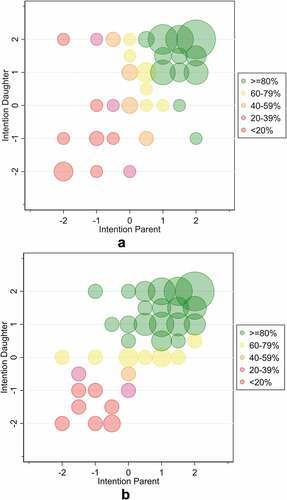Figures & data
Table 1. Baseline socio-demographic characteristics of the parents/guardians of 12–13 year-old girls, HPV-vaccination intention, actual childhood vaccination and HPV vaccination uptake, stratified by country of birth of parents; HPV vaccination acceptability study in Amsterdam, the Netherlands, 2014
Table 2. Association between HPV vaccination intention and vaccination uptake of 12–13 year-old daughters and their parents stratified by ethnicity. HPV vaccination acceptability in Amsterdam, the Netherlands, 2014
Figure 1. Heat map of the marginal prediction of HPV vaccination uptake corresponding to each combination of HPV vaccination intention among parents and their daughters. (a). Dutch parent-daughter dyads. (b). Non-Dutch parent-daughter dyads. Circle size is proportional to the number of parent-daughter dyads for a given combination of intentions; non-observed combinations were omitted from the graph. The color of the circle indicates that ≥80% (green), 60–79% (yellow), 40–59% (orange), 20–39% (pink) or <20% (red) of daughters for a given combination were vaccinated against HPV

Figure 2. Generalized structural equation model including determinants of the intention of parents and daughters associated with HPV vaccination uptake. 2a. Dutch parent-daughter dyads. 2b. Non-Dutch parent-daughter dyads. The numbers next to each pathway indicate the regression coefficient (β) and the 95% confidence interval. ε indicates the random error component within the individual regression models. In the Dutch GSEM: the pathway between attitude and past experiences with cervical cancer was removed from the model as it was not significant

